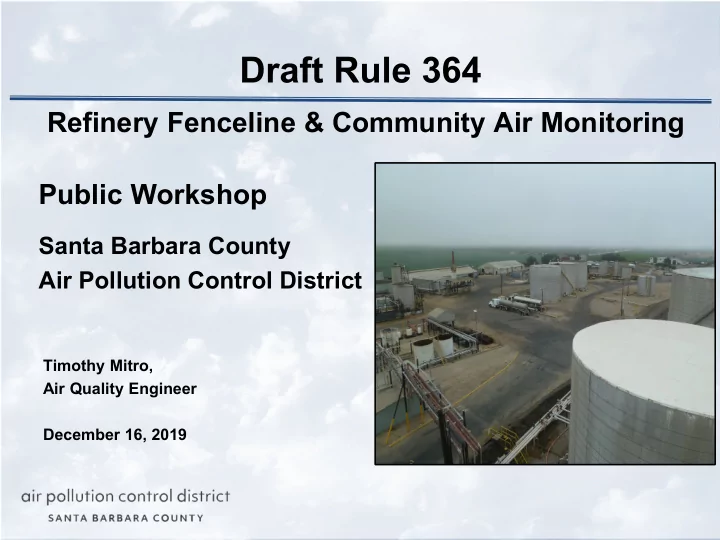

Draft Rule 364 Refinery Fenceline & Community Air Monitoring Public Workshop Santa Barbara County Air Pollution Control District Timothy Mitro, Air Quality Engineer December 16, 2019
Outline of the Presentation 1) Assembly Bill 1647 2) Santa Maria Asphalt Refinery 3) Fenceline Monitoring 4) Community Air Monitoring 5) Rule Development Timeline 2
Assembly Bill 1647 (2017-2018) • Concerns about public health and air quality impacts from refineries. • AB 1647 approved by the Governor of California on October 8, 2017. – Applicable to 1 refinery within Santa Barbara County. • AB 1647 requires the following: 1) Petroleum refineries install, operate, and maintain a fenceline air monitoring system. 2) Air districts install, operate, and maintain a refinery-related community air monitoring station. 3) Real-time data is made accessible to the public. 4) Refineries are responsible for the costs to implement the requirements. 3
Santa Maria Asphalt Refinery • Originally constructed in 1932. • Current owner is California Asphalt Production Inc. • Produces up to 10,000 barrels per day of petroleum-based products. – Includes naphtha, kerosene distillate, and gas oils. – Majority of product is used in asphalt production. • Permitted equipment at the facility includes: – Fractionator tower, – Boilers and process heaters, – Storage tanks, and – Loading racks. 4
Santa Maria Asphalt Refinery 5
Santa Maria Asphalt Refinery • Refinery is subject to permit conditions, regular District inspections and on-going reporting requirements. • Applicable rules that reduce air emissions include the following: – Rule 331: Leak Detection and Repair (LDAR) program. – Rule 325/326: Vapor recovery on storage tanks. – Rule 346: Vapor recovery on loading rack. – Rule 342/361: Low NOx burners on combustion units. – Stationary Diesel ATCM: Limits on emergency engines. 6
Fenceline Monitoring • Criteria Pollutants – Sulfur Dioxide (SO 2 ) and Nitrogen Oxides (NOx) • Reactive Organic Compounds – Total ROCs, Formaldehyde, Acetaldehyde, Acrolein, 1,3 Butadiene, Styrene – BTEX (Benzene, Toluene, Ethylbenzene, Xylenes) • Other Compounds – Hydrogen Sulfide, Carbonyl Sulfide, Ammonia, Black Carbon, Hydrogen Cyanide * Pollutant list is based on the OEHHA Analysis of Refinery Chemical Emissions [March 2019] and the SCAQMD Rule 1180 list. 7
Fenceline Monitoring • Open Path Fenceline Monitoring Technologies – Collect measurements over a larger area compared to traditional point source monitors – Fourier Transform Infrared Spectroscopy (FTIR) – Ultraviolet Differential Optical Absorption Spectroscopy (UVDOAS) 8
Fenceline Monitoring • Monitoring Plan submitted 3 months after rule adoption. • Needs to conform with the District’s Fenceline Air Monitoring Plan Guidelines: – Equipment specifications and justification that the equipment will accurately measure real-time pollutant levels. – Timeline for installing the equipment. – Procedures for equipment maintenance and failures. – Procedures for QA/QC by a qualified independent party. – Methods for disseminating data to the public. • After District approval of the Monitoring Plan, the refinery has 6 months to install and operate the fenceline system. 9
Refineries in Other Districts # Applicable District Rule Number Adoption Date Refineries Bay Area AQMD Reg 12, Rule 15 April 20, 2016 5 South Coast AQMD Rule 1180 Dec 1, 2017 7 Proposed San Joaquin Valley APCD Rule 4460 3 Dec 2019 SLO County APCD N/A N/A 1 10
Public Data - Example 11
Community Monitoring • District must operate a community monitor to measure the same refinery-related pollutants. • Nearest monitoring station is in central Santa Maria. – Monitors ozone, NO 2 , CO, PM 10 , and PM 2.5 – Unlikely to adequately monitor refinery pollutants based on wind patterns. • The District is evaluating locations to move the existing station and co-locate the community monitoring station. 12
Potential Community Locations 13
Community Monitoring Costs • Refinery responsible for all costs to implement. – Initial costs: Used to purchase new monitoring equipment. – Annual costs: Includes costs for the site lease, electricity, maintenance, and District staff time. • Costs are based on the analysis performed by the SCAQMD and adjusted downward based on District staff assessment. • If the community monitor is co-located within the District’s ambient air monitoring network, fees will be shared/reduced. 14
Rule Development Timeline • December 16, 2019: Public Workshop • January 7, 2020: Provide written comments • Tentative – Late January 2020: Community Advisory Council – Typically held in Buellton – Updated Rule & Staff Report will be released prior to the event • Tentative – March 19, 2020: Board Hearing 15
Questions? Contact Info: Timothy Mitro Air Quality Engineer 805-961-8883 MitroT@sbcapcd.org Written comments requested by January 7, 2020.
Recommend
More recommend